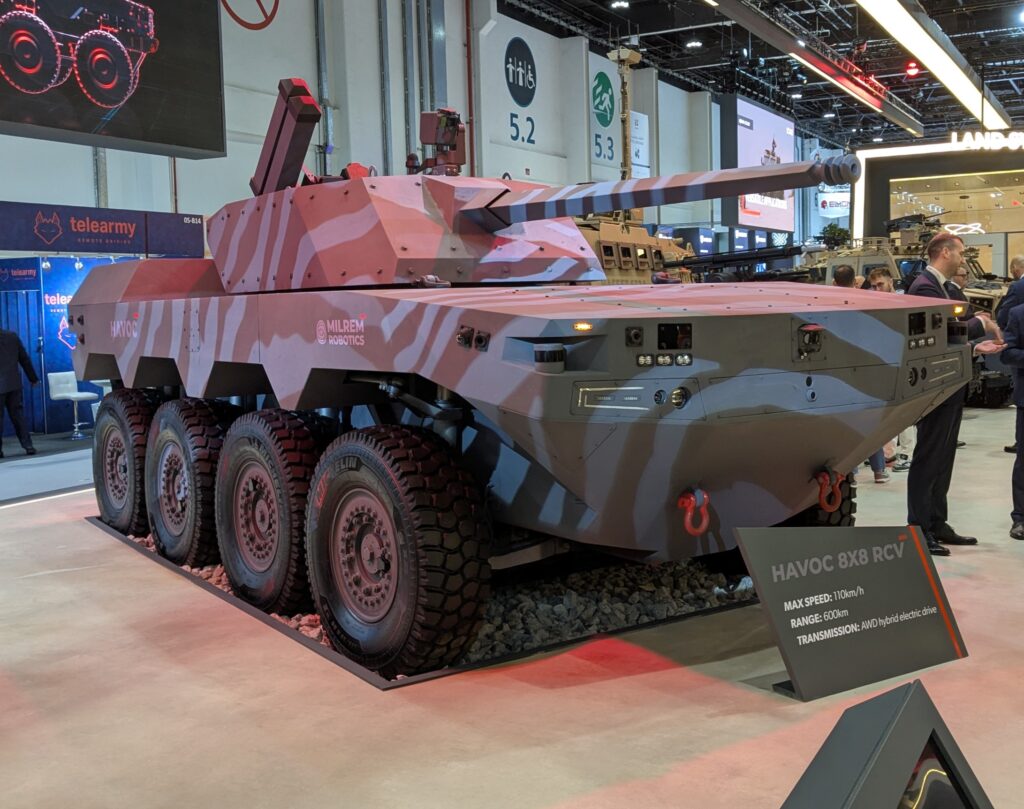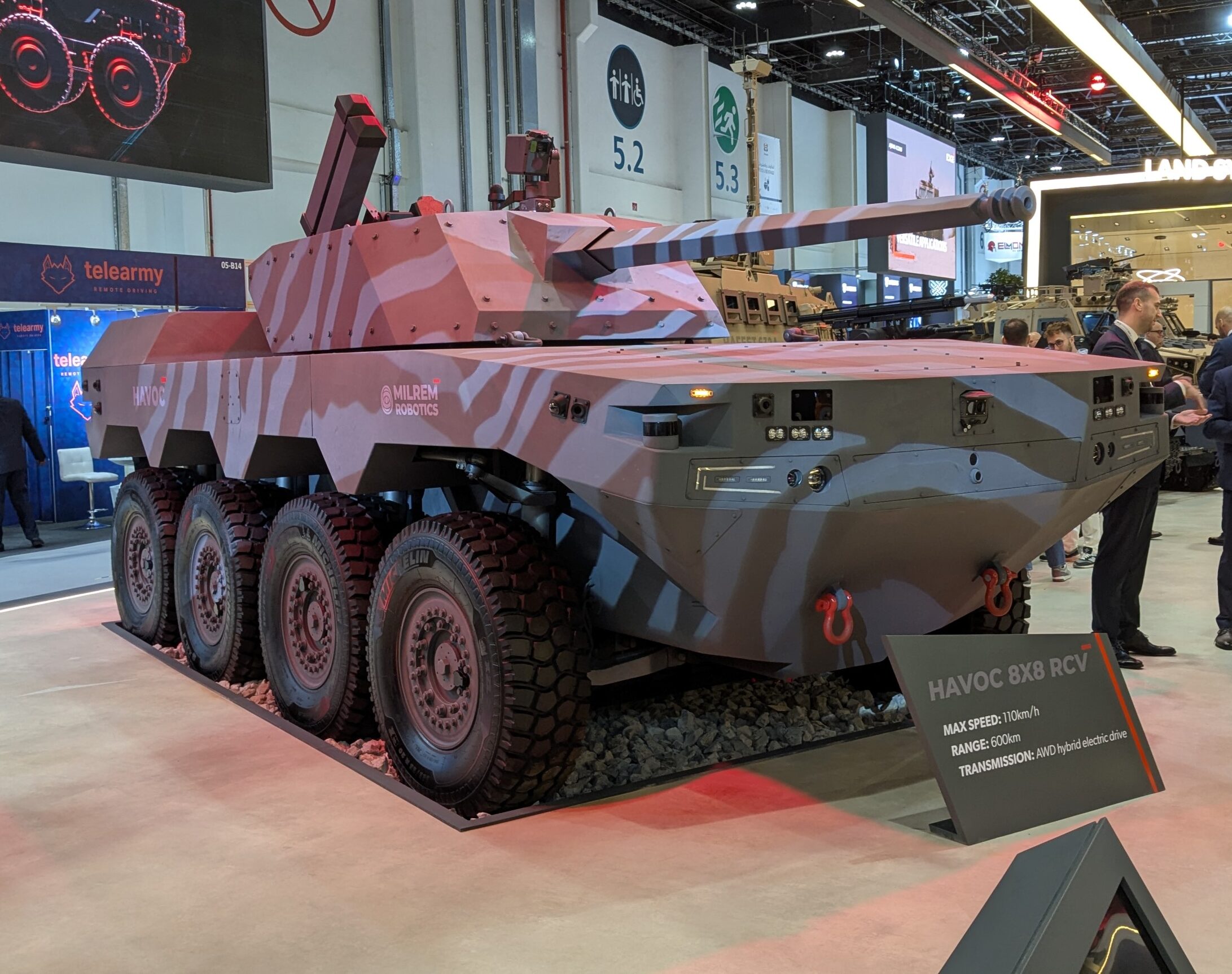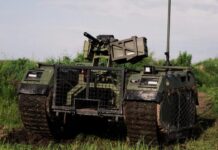Estonian unmanned ground vehicle (UGV) specialist Milrem Robotics unveiled a new 8×8 robotic combat vehicle (RCV) concept at the IDEX 2025 defence exhibition, held in Abu Dhabi from 17-21 February.
A full-size mock-up of the RCV, called the Havoc, appeared at IDEX on the expansive stand of Emirati defence conglomerate EDGE Group, which owns a majority share in Milrem Robotics.
The Havoc RCV is 6.5 m long, 2.7 m wide and weighs around 12 tonnes without payload. Propelled by all-wheel hybrid electric drive (HED) powertrain that offers near-silent movement capabilities, the Havoc has a maximum road speed of 110 km/h, a maximum off-road speed of 50 km/h and a range of 600 km. Mobility-wise it is stated to be able to negotiate gradients up to 60%, side slopes up to 40%, vertical steps of 0.6 m and can ford waters up to 1 m deep.
The Havoc’s roof has been designed to accommodate any payload up to five tonnes. The mock-up presented at IDEX 2025 featured a turreted 30 mm cannon, although a Milrem Robotics video presentation at IDEX 2025 also showed payload modules that included a counter-unmanned aerial vehicle (C-UAV) system, an anti-tank missile launcher, counter-battery and surveillance radar fits and a turreted mortar. Speaking to ESD at IDEX 2025 on 18 February, Milrem Robotics Chief Sales Officer Patrick Shepherd noted that the Havoc could accommodate a main weapon up to 57 mm in calibre.
“Weighing substantially less than conventional manned 8×8 vehicles, the [Havoc] RCV boasts superior off-road performance, making it highly effective in rugged terrains,” Milrem Robotics stated in a company press release. “Its cutting-edge electric driveline delivers instantaneous torque, enabling faster response times and enhanced mobility. Additionally, the vehicle’s pivot steering capabilities allow for a dramatically reduced turning radius, ensuring optimal manoeuvrability in environments ranging from open deserts and urban combat zones to high-altitude mountain passes.”
The company additionally noted that, by sharing common subsystems with other Milrem Robotics UGV and RCV platforms, the Havoc has significantly reduced development, procurement and maintenance costs. It also operates on a unified autonomy ecosystem that aligns with Milrem’s existing platforms, which Milrem says guarantees compatibility and scalability across a diverse range of autonomous solutions.
Milrem Robotics’ Shepherd explained to ESD that the Havoc has been designed as a force multiplier especially suitable for smaller forces that have to patrol large expanses of terrain.
“You can cover huge amounts of areas and, with Starlink and other satellite communications, these vehicles can operate far in front of the actual operators,” he said. “In Sweden we just did a test with the Swedish Defence Forces where, using Starlink, we were able to communicate to a range of more than 900 km with no delays and no safety concerns. So having that same system in a larger vehicle with a 30 mm cannon, a mortar, or any type of air defence system that could be set up gives you a huge operational advantage over any other land army because you’re going to have a forward line of robotic systems that’s operating and engaging with targets ahead of critical manned assets.
“What our Ukrainian customers are doing is they’re using the robots to identify where are the enemy’s critical capital assets, artillery systems, tanks, heavy bunkers,” Shepherd added, “and then they use that information to manoeuvre the main elements in a much safer and much more effective manner.”
Shepherd said Milrem had already had several customers interested in using an RCV as part of a manned-unmanned teaming formation, an example of this being where an RCV would autonomously move alongside a platoon of tanks to provide C-UAV cover. Such a mission would be especially relevant to the tracked version of the Havoc, called the Vector, which is at a similar stage of development as the 8×8 Havoc.
Shepard noted that the Havoc and Vector share numerous common subsystems – such as the powerplant, batteries, cooling system, control algorithms and autonomy kit – with the exception of the transmission drivelines, which are fundamentally different between the wheeled and tracked RCVs.
The first functional Vector RCV will be up and running in 2026, said Shepherd. With regard to Havoc, meanwhile, he remained somewhat coy. “We have a system; I don’t know when it’s going to be disclosed to the public,” he said. “Once you see it, you realise what we’re doing. It’s very, you know, we’re all engineers, right? I think we’ll probably show it to the public at IDEX in 2027.”
In the meantime, Milrem is continuing with reliability and functionality testing with both Havoc and Vector to make sure they operate as intended.














